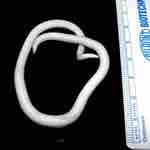Helminthsare large, multicellular organisms that are visible to the eye once in the adult stage of their life cycle. Helminths and multicellular eukaryotes, can either be free-living or parasitic.
In their adult form, helminths are unable to multiply in humans and utilize numerous mechanisms of transmission to ensure reproductive success. These parasites live in and feed on hosts which allow them to obtain nourishment while disrupting the hosts' nutrient absorption. Parasitic worms are commonly found within the intestine and thus, are called intestinal parasites. They are able to live in both humans and animals.
The major groups of parasitic helminths include:
- platyhelminths (flatworms)
- acanthocephalins (thorny-headed worms)
- cestodes (tapeworms)
- trematodes (flukes)
- nematodes (roundworms).
The classification and identification of helminths are dependent on numerous factors including body shape, body cavity, body covering, digestive tubing, sex and type of attachment organs.
Platyhelminths (flatworms) include both trematodes (flukes) and cestodes (tapeworms). Specifically, tapeworms are characterized using the above criteria and are organized in a segmented plane. They lack a body cavity and have a tegument body covering. Tapeworms lack a digestive tube and are hermaphroditic. They utilize suckers or bothridia, and rostellum with hooks for an attachment organ .
Trematodes are characterized by an unsegmented plane for body shape. They also lack a body cavity and have a tegument for body covering. However, the digestive tube for trematodes ends in the cecum. Trematodes are hermaphroditic and utilize oral suckers, ventral suckers or acetabulum for attachment organs.
Nematodes are characterized by a cylindrical body shape and do indeed have a body cavity. Its body covering is a cuticle and the digestive tube ends in the anus. The sex of nematodes is dioecious (distinct male and female organisms). Lastly, their attachment organs range from lips, teeth, filariform extremities and dentary plates.

Helminths
Image of a tapeworm, specifically an adult Ascaris lumbriocoides worm.